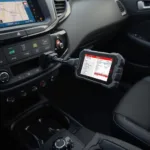The OBD2 diagram, a roadmap to your vehicle’s diagnostic system, is essential for understanding how your car communicates its health. This guide dives deep into the intricacies of OBD2 diagrams, providing you with valuable insights into their structure, usage, and benefits. Whether you’re a seasoned mechanic or a curious car owner, this comprehensive guide will equip you with the knowledge to effectively utilize OBD2 technology.
Decoding the OBD2 Diagram
OBD2, or On-Board Diagnostics II, is a standardized system used in vehicles to monitor and report various systems’ performance. The OBD2 diagram visually represents this system, showing the location of the OBD2 port and its connection to different control modules within the car. This diagram serves as a crucial tool for troubleshooting car problems, allowing you to quickly identify the source of an issue. Understanding the diagram’s components and their interrelationships is key to effectively diagnosing and repairing vehicle malfunctions. It provides a visual representation of the communication network between the various electronic control units (ECUs) in your car and the OBD2 port.
What Does an OBD2 Diagram Show?
The OBD2 diagram typically shows the physical layout of the OBD2 connector, pinpointing each pin’s function. It also illustrates how these pins connect to the vehicle’s various ECUs, such as the engine control module (ECM), transmission control module (TCM), and body control module (BCM). By understanding the diagram, you can determine which pins correspond to specific communication protocols and data streams, allowing you to access the information you need for diagnostics.
Understanding the OBD2 diagram is vital for both DIY enthusiasts and professional mechanics. It allows for targeted diagnostics, saving time and effort by pinpointing the specific area needing attention.
How to Use an OBD2 Diagram
Using an OBD2 diagram effectively involves understanding its components and relating them to your specific vehicle’s system. The diagram provides a roadmap for locating the OBD2 port, identifying the relevant pins, and understanding the data flowing through them. This information is crucial for accurately interpreting diagnostic trouble codes (DTCs) retrieved from an OBD2 scanner.
Locating the OBD2 Port
Most vehicles manufactured after 1996 have a standardized OBD2 port located within the driver’s reach, often under the dashboard or steering wheel. The OBD2 diagram can help you locate the port if you’re unfamiliar with its placement in your specific vehicle model.
Interpreting the Pin Configuration
The OBD2 connector has 16 pins, each with a designated function. The diagram details each pin’s role, specifying whether it’s used for power, ground, communication, or specific diagnostic functions. Knowing the pin configuration is essential when using advanced diagnostic tools or performing custom wiring modifications.
Benefits of Using an OBD2 Diagram
Utilizing an OBD2 diagram offers numerous benefits, empowering you to take control of your vehicle’s diagnostics. From identifying the root cause of a check engine light to monitoring critical system parameters, the OBD2 diagram is a valuable resource.
Efficient Troubleshooting
The diagram facilitates efficient troubleshooting by allowing you to pinpoint the faulty system or component. This targeted approach saves valuable time and resources compared to traditional diagnostic methods, which often involve extensive trial and error.
Improved Understanding of Vehicle Systems
Studying the OBD2 diagram enhances your understanding of your vehicle’s complex electronic systems. By visualizing the connections and communication pathways, you can gain a deeper appreciation for how the various components interact.
Cost Savings
By enabling DIY diagnostics and repairs, the OBD2 diagram can help you save money on expensive mechanic visits. toyota obd2 pins Understanding the diagram empowers you to address minor issues yourself, preventing them from escalating into costly problems.
Conclusion
The OBD2 diagram is an indispensable tool for anyone working with vehicle diagnostics. Understanding its structure and application empowers you to effectively troubleshoot car problems, save money on repairs, and gain a deeper understanding of your vehicle’s intricate systems. By utilizing this guide and exploring resources like the toyota obd2 pins page, you can unlock the full potential of OBD2 technology and take control of your vehicle’s maintenance.
FAQ
- What does OBD2 stand for? On-Board Diagnostics II
- Where can I find the OBD2 port in my car? Typically under the dashboard or steering wheel, within the driver’s reach.
- How many pins does an OBD2 connector have? 16
- What information can I get from an OBD2 scanner? Diagnostic trouble codes (DTCs), sensor data, and other system parameters.
- Why is understanding the OBD2 diagram important? It allows for efficient troubleshooting and a better understanding of your vehicle’s systems.
- Can I use the OBD2 diagram to fix my car myself? The diagram can help you diagnose the problem, which can then guide you towards a solution or inform you about the needed repair.
- Where can I find an OBD2 diagram for my specific car model? Owner’s manual or online resources.
Need further assistance? Contact us via WhatsApp: +1(641)206-8880 or Email: [email protected]. Our 24/7 customer support team is ready to help.

